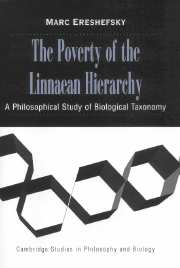8 - The Future of Biological Nomenclature
Published online by Cambridge University Press: 16 July 2009
Summary
The last chapter introduced and analyzed a number of proposals for an alternative system of classification. The best parts of those proposals were then woven into a post-Linnaean system containing eleven recommendations. Those recommendations address three aspects of biological taxonomy: how to represent the hierarchical relations of taxa, how to name taxa, and how to define taxon names. With those recommendations in hand we can now compare the post-Linnaean system with the Linnaean system. But to do that we must decide which version of the Linnaean system should be used as a basis for comparison, for as Chapter 6 illustrates the Linnaean system has gone through more than one incarnation. To put the Linnaean system on its best footing, we should pick the best developed version of that system. Arguably, the most complete and up-to-date version is Wiley's (1979, 1981) “Annotated Linnaean Hierarchy.”
This chapter contains a comparison of the annotated Linnaean system with the post-Linnaean system developed in the previous chapter. Section 8.1 introduces the annotated Linnaean system and many of its problems. Section 8.2 turns to the post-Linnaean system and examines whether the post-Linnaean system does a better job at overcoming those problems. Section 8.3 steps back from a detailed comparison of the two systems and considers a more general issue. Suppose the post-Linnaean system better coheres with evolutionary theory and, if adopted, would make the job of taxonomists easier. Suppose, in other words, that the post-Linnaean system is preferable for both theoretical and pragmatic reasons.
- Type
- Chapter
- Information
- The Poverty of the Linnaean HierarchyA Philosophical Study of Biological Taxonomy, pp. 267 - 291Publisher: Cambridge University PressPrint publication year: 2000



